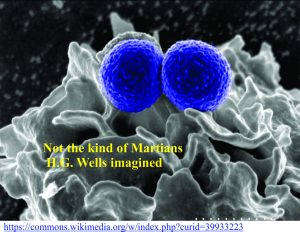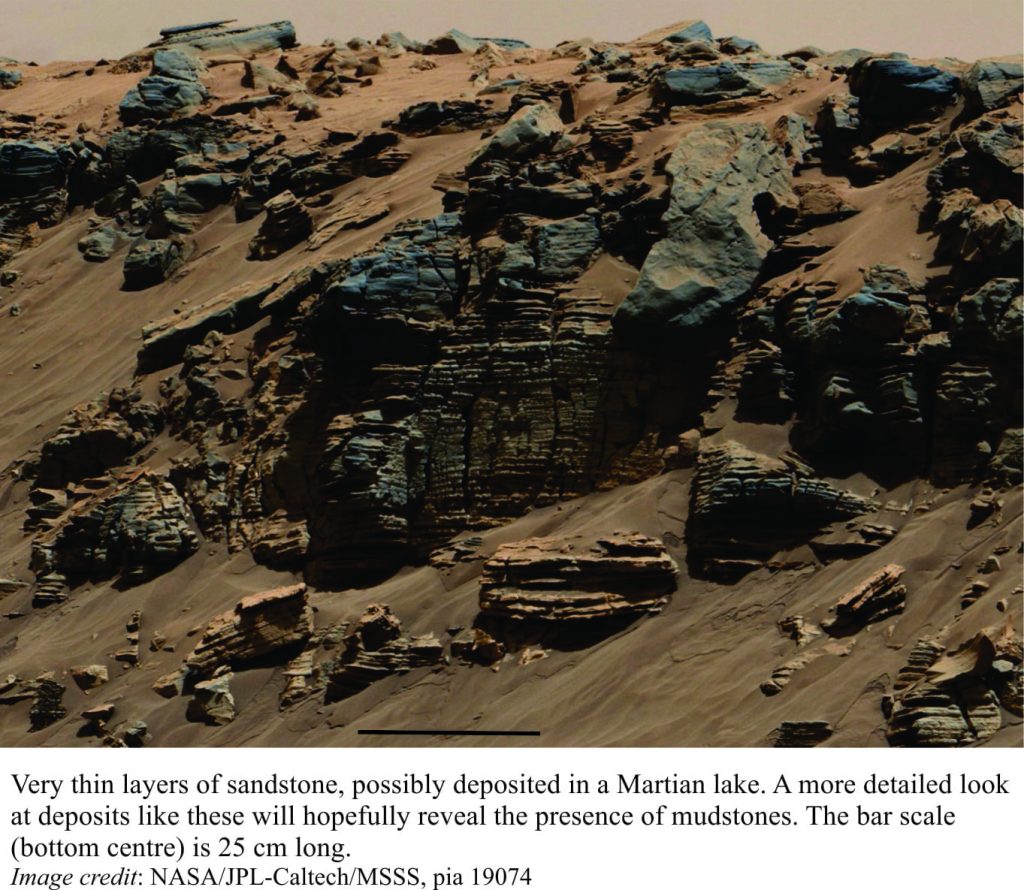I believe alien life is quite common in the universe, although intelligent life is less so. Some say it has yet to appear on planet Earth. Stephen Hawking
I can only imagine H.G. Wells bitter disappointment if he were to learn that Martians were little more than primitive microbes. All that hype and scare-mongering for nothing. Because that, it seems, is all we are ever likely to find on Mars. They may be intelligent microbes, but microbes nonetheless.
Present conditions on Mars are not conducive to thriving populations of anything living – at least in any life form we are familiar with. Incident UV and other solar radiation, low atmospheric pressure, an atmosphere almost devoid of oxygen, and the presence in soils of oxidizing molecular compounds such as perchlorates and hydrogen peroxide (think bleached hair), all contribute to rather inclement living conditions. It is possible that some life forms have survived these ravages, in sheltered enclaves or buried beneath the scorched earth, but it is more likely that, if life did exist on Mars, we will find the evidence written into ancient sedimentary rocks, or perhaps as chemical signatures. It is these attributes that current exploration programs, both landed rover expeditions and orbiting satellites, tend to focus on.
Earth-bound life forms, particularly microbes, can thrive in a multitude of environments. We are constantly reminded of this in our own, relatively benign conditions (the right amount of oxygen, clement temperatures and climates), but we also know that microbes and other life forms have evolved in conditions that are extreme; highly acidic geothermal pools, ocean depths devoid of sunlight, the throats of volcanoes, or buried beneath tonnes of ice. The common denominator for all these microbial kitchens is water, water that is used directly, or indirectly via water-soluble compounds such as sulphates, chlorides and carbonates.
Surface water on Mars is scarce; some is locked up as ice at the Martian poles, and perhaps buried in dirt (frozen groundwater – a bit like our Arctic permafrost). However, Mar’s deeper past (measured, like Earth, in billions of years), was quite different. There is very good evidence (found in sedimentary rocks and minerals), for liquid water that once flowed in rivers, carved ravines and moulded landscapes, rivers that shaped sediment into large deltas, and seas with distant shores.
Scientists can take the watery, Earth-like analogies further in their search for Martian biology, by focussing their attention on muddy rocks. Earthly mud rocks, or mudstones, commonly have evidence for biological activity, either as actual body fossils, or as organic compounds that have survived the vagaries of burial and chemical change; oil and gas deposits represent a kind of end-point of these processes, the culmination of a transformation of organic matter from living creatures or plants. Certain kinds of molecules, or biomarkers in these deposits, allow us to determine the original kinds of organisms from which the hydrocarbons were derived. We can use the same technology to examine Martian mudstones, to search for biomarker molecules that might point to former organisms.
Specific biomarkers for earth organisms include DNA-RNA, various proteins, amino acids, and steroids, although these molecules tend not to survive intact during geological burial. Compounds like lipids, on the other hand, can be preserved relatively intact – they are found in various hydrocarbons and organic-rich mudstones. A very important distinction needs to be made here, between organic molecules that can be attributed to life forms, and those that form by abiotic processes (not involving life forms). Abiotic organic molecules are no strangers to those who study organic matter on extra-terrestrial flotsam; they have been found on meteorites, identified in the spectra of interstellar gas clouds, and were detected on the European Space Agency’s Rosetta recent mission to comet 67P/Churyumov-Gerasimenko.
Mars, as a habitat in its distant, more watery past, may have had some similarity with conditions on earth 3-4 billion years ago, where the earliest life forms (microbes) are hypothesized to have developed in localized prebiotic factories, perhaps associated with hydrothermal and volcanic vents; not unlike Darwin’s “warm little ponds”. Hydrothermal vents, like the black smokers we observe today in deep oceans, could have provided heat and nutrients in the form of chemical compounds. Organisms that obtain their metabolic energy from chemicals like sulphates and iron oxides, instead of sunlight, are called chemotrophs. Mars habitats, it has been suggested, also were localized, but did not have the kind of longevity that earth systems possess. It is also hypothesized that Martian organisms were probably chemotrophic, and, because there was little or no oxygen, anaerobic.
The utility of Earth-Mars analogues, such as organic biomarkers, or comparisons with the life habitats on earth, are useful not because they offer any kind of confirmation of life on Mars, but because they help to focus the search for the kind of evidence that can be interpreted with confidence. This includes a focus on analytical methods, but perhaps more importantly it helps to provide direction on ‘where’ to look, based on knowledge of the geology and Martian landscapes. For example, if the exploration program is to concentrate its search for organic signatures in mudstones, then ancient Martian lakes are good places to start looking. The current mission (Curiosity), and the upcoming ExoMars (European Space Agency, 2020 launch), and NASA’s Mars 2020 missions, will provide initial glimpses into some of these habitats, and perhaps some answers to an age-old question.



















